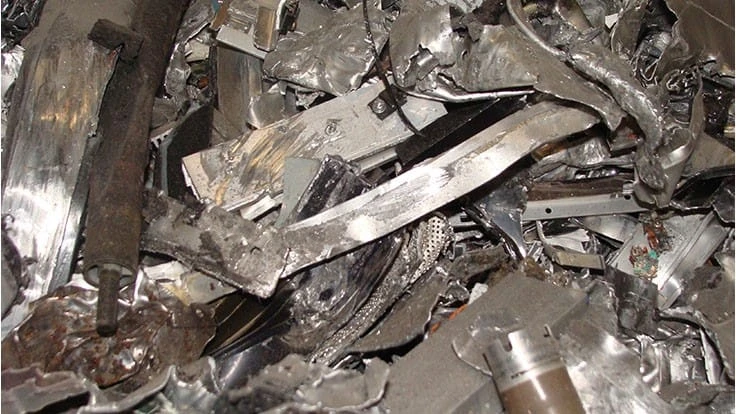
Photo by Brian Taylor.
Prompt scrap rose in value yet again in April, according to Fastmarkets AMM pricing surveys. Clean ferrous scrap generated at factories is now worth about $565 per ton in the United States Midwest, more than double the $273 it was worth in April 2020.
Overall, economic activity in the United States and beyond seems to be gaining momentum in tandem with vaccination rates, and the purchase, processing and sale of ferrous scrap is part of a wider effort to return the economy to its pre-COVID-19 footing.
Steel output in the United States has rebounded by some 500,000 tons per week compared with the doldrums of April 2020. However, the mill capacity rate in the U.S. remains in the 77 percent range, even though steel prices might lead one to believe mills cannot keep up with booming demand.
For scrap processors, the April buying period brought a further diversion between the value of prompt scrap grades (nearly $565 per ton, according to Fastmarkets AMM) and obsolete grades. The publication has April shredded shipments fetching about $138 per ton less from mills in the Midwest, while No. 1 heavy melting scrap (HMS) selling for even less.
Export buyers also paid less in April for HMS obsolete grades, according to Fastmarkets AMM, since scale prices have been lofty enough to bring material across the scale at a rate to meet much of the global demand.
For domestic buyers of prompt scrap, sufficient supply has not been so readily available, with the semiconductor chip shortage affecting automotive assembly carrying on into the early second quarter of the year.
The situation in the auto industry could be one reason why mills in the U.S. are not yet roaring back to full capacity the way they are in other parts of the world, where steel heading into construction and infrastructure applications is more common.
Steel industry consultant Becky E. Hites of Atlanta-based Steel Insights LLC sees room to grow in North American steel output and, in the short term, possibly even in pricing.
In an early April presentation, Hites remarked that mill utilization rates in the U.S. “remain below the 80 percent targeted benchmark” for the industry.
When COVID-19 pinched steel demand, nimble electric arc furnace (EAF) and other operators in the U.S. responded by cutting capacity. Now, even though hot-rolled steel is fetching high-end prices, mills remain reluctant to move into an overcapacity situation.
Hites said, “U.S. mill shipments were down an estimated 16 percent in 2020, while consumption dropped 19.6 percent.” Regarding 2021, she added, “Q1 2021 was down 5 percent, but we estimate [shipments] will be up more than 35 percent in Q2 2021.”
The rebound could be boosted by an agreement between America’s two major political parties to fund infrastructure improvements that could see federal money go toward highway, bridge and drinking water projects.
At the end of March, President Joe Biden’s administration unveiled its American Jobs Plan, which would entail funding road and rail transportation, power grid and telecommunications projects that would likely require hundreds of thousands of tons of steel, copper, aluminum and other basic materials.
The Washington-based American Iron and Steel Institute (AISI) expressed support for the plan, with Kevin Dempsey, its president and CEO, stating, “AISI greatly appreciates President Biden’s commitment to building back better America’s roads, bridges, waterways, rail, electrical grid and other critical infrastructure – and doing it with American made steel.”
Adds Dempsey, “Each $1 billion in infrastructure spending requires about 50,000 net tons of steel, and each $1 trillion invested in infrastructure has the potential to create 11 million jobs in our economy over the next decade.”
The Washington-based Institute of Scrap Recycling Industries (ISRI) also said it “applauds President Biden’s proposal to inject long-overdue federal funding into the nation’s transportation infrastructure.”
Not all players in the U.S. economy are as enthusiastic about either the Biden plan or the surging price of finished steel that likely would be exacerbated by a big-ticket infrastructure program.
The Arlington, Virginia-based Associated General Contractors of America (AGC) has expressed opposition to some construction labor law aspects of the Biden proposal. The group also has been watching the rising price of steel with concern.
In an April 9 news release, AGC mentions an “unprecedented leap in the price of goods used in construction,” and singled out steel as one of the culprits. The AGC also points to “supply chain disruptions” and tariffs as issues to be addressed by the federal government before it begins funding projects.
“The Biden administration must address soaring lumber and steel costs and broader supply chain woes with the same energy [it is] putting into dealing with shortages of automotive microchips,” says Stephen E. Sandherr, the association’s CEO.
He continues, “Without tariff relief and other measures, construction employers will have little ability to invest in new equipment and hire new employees.”
Referring to a government index that measures the selling price for goods used in construction as rising 3.5 percent from February to March 2021 and 12.9 percent since March 2020, AGC Chief Economist Ken Simonson comments, “These material cost increases are based on prices the government collected a month ago, and they fail to capture the notices contractors are receiving daily about longer lead times, shipments held to a fraction of previous orders and other challenges.”
Latest from Recycling Today
- Aqua Metals secures $1.5M loan, reports operational strides
- AF&PA urges veto of NY bill
- Aluminum Association includes recycling among 2025 policy priorities
- AISI applauds waterways spending bill
- Lux Research questions hydrogen’s transportation role
- Sonoco selling thermoformed, flexible packaging business to Toppan for $1.8B
- ReMA offers Superfund informational reports
- Hyster-Yale commits to US production





